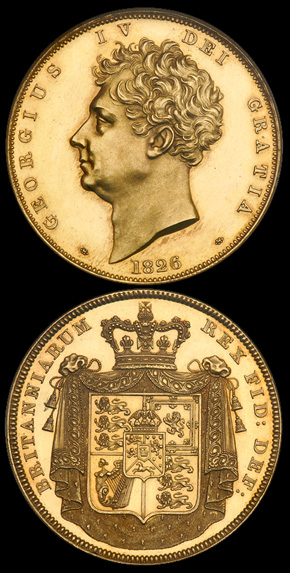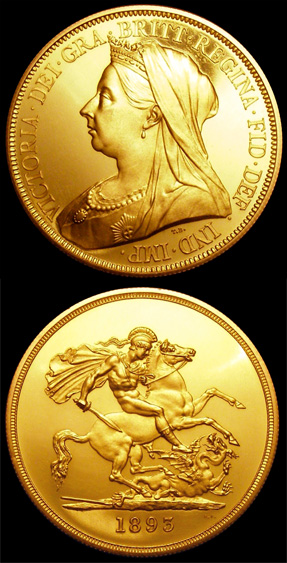English Gold Coins:
English Gold Coins (overview) | Gold Penny | Gold Florin | Gold Noble | Gold Ryal | Gold Laurel | Gold Unite | Triple Unite | Gold Crown | Gold Angel | Gold Guinea | Gold Coins Of The Black Prince | Five Guineas | Gold Sovereigns | Fine Sovereign | Double Sovereign | Two Pound Coin | Five Pound Coin | Gold Proof Coins | Elizabeth II Diamond Jubilee Gold Coins
Five Pound Coin
Share this page:

Gold 5 Pound Coin of George IV (S.3797), 1826
Proof, Rev. Crowned Shield and Mantle.
The five pound coin is a denomination that "officially" first started with the 100 shilling five guinea of Charles II. However the value of the guinea fluctuated over time; also the guinea coins from before the Great Recoinage of 1816 had a different look and feel - so the five guinea coin is generally considered a separate series by collectors. [1]
George III Five Pound Coin
The first appearance of the five pound coin was at the end of the reign of George III, when it was produced in 1820. (S.3783) The obverse shows the right-facing bust of George III with the legend GEORGIUS III D. G. BRITANNIAR. REX F.D. and the date. The reverse shows the now famous St. George and dragon design of Benedetto Pistrucci (1784-1855) with no legend.
This coin exists in two versions: one with the edge inscribed and one with plain edge. Both are considered "pattern only" proof coins and are extremely rare and valuable, being listed for £70,000 and £85,000 respectively in FDC condition. [2]
William IV Five Pound Coin
The next five pound coin was an 1826 proof of William IV (S.3797; see image left). It is estimated that fewer than 200 of these coins exist and many were included in an 11-piece "proof set" for that year, in which they are usually found. Examples may realize $15,000 at auction in or close to FDC condition. The 1826 coin features either plain edge or the edge inscription DECUS ET TUTAMEN ANNO REGNI SEPTIMO. There is also a Piedfort ("heavy foot") proof version of this coin, weighing 46.5 grams instead of the regular 39.8-40.0 grams. This coin has plain edge and is thought "probably unique".
The William IV five pound gold coin was also produced in 1829. Only one example exists, 38.7 grams with plain edge; a proof or a pattern.
Victoria Five Pound Coins
Una And The Lion five pound coin
The next time the gold five pound coin appears was in the reign of Victoria (1837-1901). In 1839 a gold five pound was issued, and this coin has acquired cult status among collectors rivalled only by a few coins such as the 1847 gothic crown. The 1839 coin is known as the "Una and the Lion" coin. Una and the Lion are characters in Spenser's The Faerie Queene and appear on the reverse.

Victoria Five Pounds (S.3872), 1893
Proof, Old Veiled Bust, George and Dragon
The obverse shows the Victoria "young head", facing left with the legend VICTORIA D G BRITANNIARUM REGINA F D, while the reverse shows Queen Victoria as Una leading the lion, with the inscription DIRIGE DEUS GRESSUS MEOS – "May the Lord direct my steps". Some coins say DIRIGIT instead of DIRIGE – "The Lord directs my steps" – with the date MDCCCXXXIX in Latin beneath the lion. The edge may either have the inscription DECUS ET TUTAMEN ANNO REGNI TERTIO, in large or small lettering, or be plain. The coin weighs 38.7–39.3 grams.
Jubilee Head five pound coin
The next issue of the five pound coin was in 1887, celebrating the queen's Jubilee. This coin weighed 40 grams, features milled edging and has Pistrucci's George and the Dragon on the reverse. A rare and extremely valuable "Sydney Mint" proof of this coin exists, with the "S" mintmark appearing above the center of the date. [1]
Old Head five pound coin
The old head coin (see image left) features milled edges and the reverse of George and the Dragon.
Collectors are advised to exercise caution as very good forgeries of the 1887 and 1893 coins are known to exist. The fake coins may have the correct weight, but may have a weak strike or "too new" a look. [1]
Early 20th Century Five Pound Coins
In the reigns of Edward VII, George V, Edward VIII, and George VI, the gold five pound coin was only issued in proof sets in the first year of the King's reign. All these coins used Pistrucci's George and the Dragon on the reverse. The 1902 Edward VII coin was also issued as a "matt proof" and also minted at Sydney, being identified by an "S" above the centre of the date. The 1902 Edward VII, 1911 George V and 1937 Edward VIII coins had milled edges. The Edward VIII coin was prepared as a pattern only in very small quantity and no proof sets were issued. This coin is listed as having a value of £175,000.
George VI Five Pound Coin
A gold five pound coin was issued in 1937 as part of a four-coin cased proof set to celebrate the coronation of George VI. These coins featured a plain edge, which is often seen damaged in examples, owing to the difficulty in prising these coins from their original mounting. [1]
Elizabeth II Five Pound Coin
A very small number of gold five pound pieces were minted in 1953 and again in 1957, but neither of these pattern / proof strikings were released to the public, with the result that they are extremely rare and now valued in six figures. These coins again featured the reverse of George and the Dragon by Pistrucci.
The gold five pound coin was not issued again until 1980 - and since then the Royal Mint has been releasing them both individually and as part of proof sets. These coins make up two series: The traditional style, featuring the reverse of St. George and the Dragon, which has been released most years - and the "commemorative" style with unique artwork and a design celebrating a date of Royal significance. In addition to 22 carat gold, the commemorative coins were also issued in cupro-nickel and sometimes also in silver, in much higher quantities and since 1990 these five pound coins have been called crowns being the same size as the old five shilling crown.
Elizabeth II "Commemorative" Five Pound Coin List
Below is a table of the commemorative gold five pound coins. (George and Dragon traditional style coins are not included in this list)
| Date: | Design / Commemorating: | Number Minted in Gold: | Reverse Design: |
| 1989 | 500th Anniversary of the Sovereign | 2,937 | This coin featured "Lombardic" style lettering and a crowned shield on a double tudor rose on the reverse. |
| 1990 | Queen Mother 90th birthday | 2,500 | Reverse design by Leslie Durbin featuring thistle and rose. |
| 1993 | 40th anniversary of the Coronation | 2,500 | Reverse design features the inscription "FAITH AND TRUTH I WILL BEAR UNTO YOU" |
| 1996 | 70th birthday of Queen Elizabeth II | 2,127 | Reverse design - five flags with royal emblems and dates. |
| 1997 | Golden Wedding of Queen Elizabeth II and Prince Philip (1997) | 2,574 | Reverse design - Royal Arms and Arms of Prince Philip, with anchor below. |
| 1998 | Prince of Wales' 50th birthday | 778 | Reverse design - Prince's Trust ribbons with Portrait of Prince Charles. |
| 1999 | Diana, Princess of Wales Memorial | 7,500 | Reverse design - Greenwich Meridian |
| 2000 | Queen Mother 100th birthday Commemorative | 3,000 | Queen Mother portrait and signature |
| 2001 | 100th Anniversary of passing of Queen Victoria | 2,098 plus 733 with "reverse frosting" in four varieties (S.4554B) | Reverse design - Crystal Palace iron framework with Victoria "Young Head" portrait |
| 2002 | Golden Jubilee | 3,500 | Queen on Horseback |
| 2002 | Queen Mother Passing | 2,086 | Queen Mother 1900-2002 portrait |
| 2003 | Coronation commemorative | 1,896 | Tom Philips "God Save The Queen" unusual lettering design |
| 2004 | "Entente Cordiale" between Britain and France 100th anniversary | 926 plus 6,065 with "reverse frosting" | Britannia and Marianne upside-down form each other |
| 2005 | Trafalgar 200th anniversary | 1,805 | Ship |
| 2005 | Horatio Nelson 200th anniversary | 1,760 | Nelson Portrait. This coin also appeared (700 issued) in platinum piedfort. |
| 2006 | Queen Elizabeth II 80th Birthday | 2,750 | Trumpets w/ "VIVAT REGINA" |
| 2007 | Queen Elizabeth II and Prince Philip Diamond Wedding Anniversary | 2,500 | Westminster Abbey Rose Window |
| 2008 | 450th Anniversary of Accession of Elizabeth I | 1,500 | New portrait of Elizabeth I inside quatrefoil |
| 2008 | Prince Charles 60th Birthday | 1,500 | Prince Charles portrait |
| 2009 | 500th Anniversary of Accession of Henry VIII | 1,500 | Henry Portrait |
| 2009 | London Olympics Countdown | 4,000 | Competing swimmers |
| 2010 | London Olympics Countdown | 3,000 | Runners competing |
| 2010 | Restoration of the Monarchy | 1,200 | Heraldic crown with "Double C", English rose and Scottish thistle. |
| 2010 | Royal Engagement | 1,000 | Prince William and Kate Middleton portrait |
| 2011 | Royal Wedding | 3,000 (?) | Royal couple portrait with "William And Catherine" and date (29th April 2011) |
| 2011 | Prince Philip 90th Birthday | 1,200 | Prince Philip portrait |
| 2011 | London Olympics Countdown | 3,000 | Racing cyclist |
| 2012 | Queen's Diamond Jubilee | 3,850 | Early Portrait with "DIRIGE DEUS GRESUS MEOS" |
| 2012 | London Olympics | 5,000 | Iconic buildings of London in center circle, with motifs representing sporting events in outer circle. |
| 2012 | London Paralympics | 2,012 | Circular design featuring archery target, spoked wheel, Big Ben, stopwatch and 2012 Paralympic emblem in colour. |
References:
[1] Coincraft's Standard Catalogue of English and UK Coins (1998 ed.)
[2] Spink - Coins of England and the United Kingdom
[1] http://en.wikipedia.org/wiki/Five_pounds_(British_gold_coin)
[4] http://www.taxfreegold.co.uk/fivepoundsinfo.html




